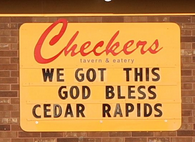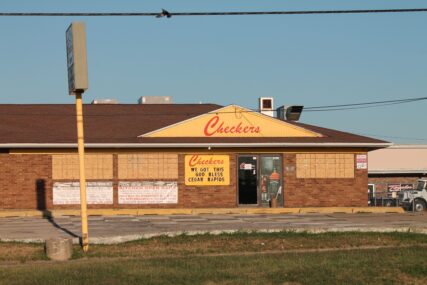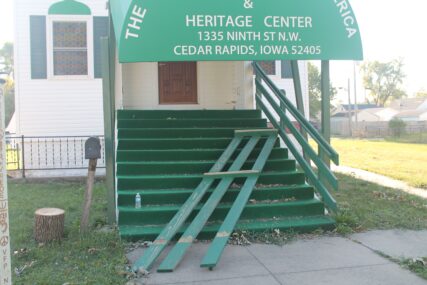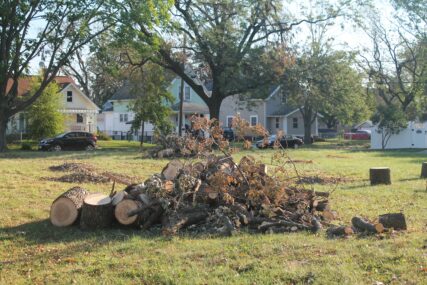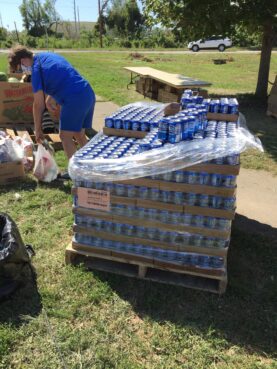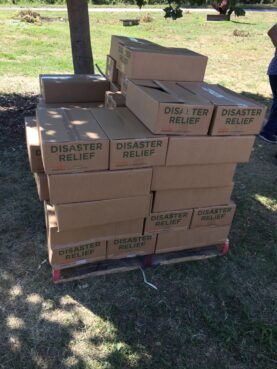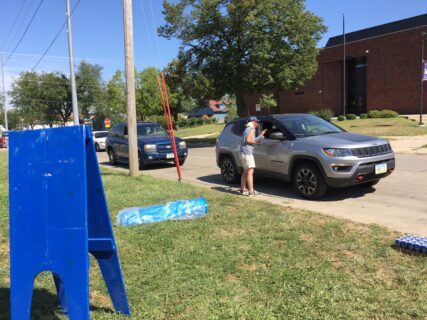(RNS) — When my husband and I arrived in Cedar Rapids, Iowa, on Friday (Aug. 21), it was at the tail end of a pretty blissful road trip. We had seen a brief headline or two about storms in Cedar Rapids and elsewhere in the Midwest on Aug. 10, but hadn’t seen much about it since then, so it was largely off our radar.
Eleven days after the derecho storm, we pulled in to the outskirts of town after a day of fun (did you know there is an entire museum in southern Minnesota devoted to the history of Spam lunchmeat?) and something began to feel … off. Street signs were askew, or else nonexistent. Billboards had been torn down across the town, some still dangling from their frames. Siding and roofing had peeled off houses and commercial buildings, which now featured a hodgepodge of temporary Tyvek. Aluminum trim and roofing looked like so much crumpled tin foil.
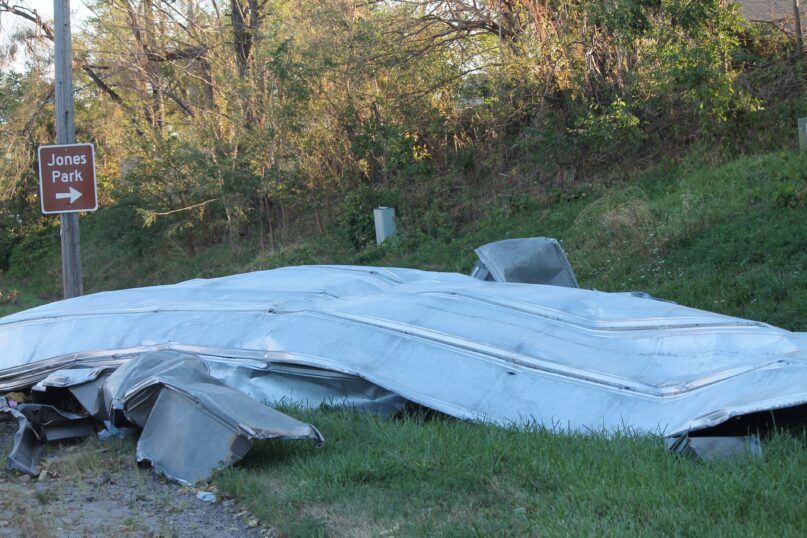
Cedar Rapids, Iowa, Aug. 21, 2020. Photo by Phil Smith
Worst of all were the trees. Thousands of them had been reduced to stumps or were cloven in two. And I’m not just talking about little new treelets, but the well-established, century-old grande dames that shelter a community. Here’s one that was destroyed in the cemetery.
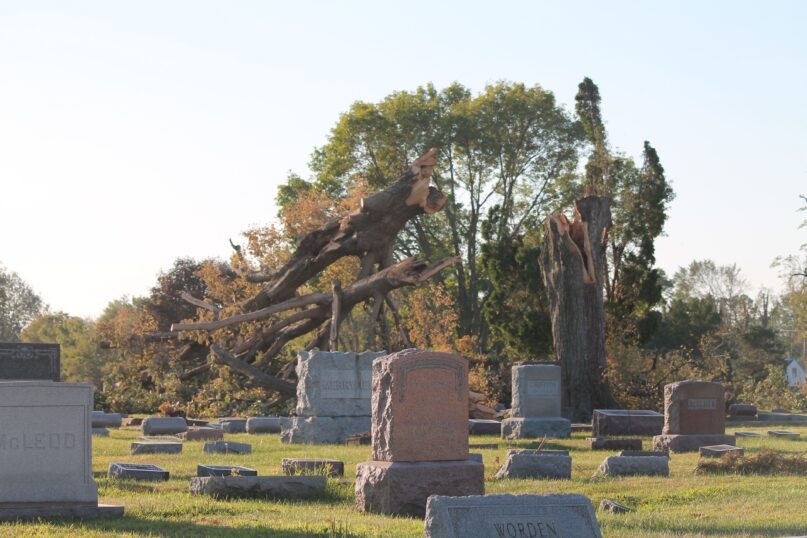
Cedar Rapids, Iowa, Aug. 21, 2020. Photo by Phil Smith
We were stunned. How had we not heard how bad things were in Cedar Rapids?
The diner where my husband went to order takeout had closed because of storm damage. The diner may have also been without power; even 11 days afterward, thousands of people still didn’t have it. Not to be cowed by the storm, however, here was the sign on its marquee:
- Cedar Rapids, Iowa, Aug. 21, 2020. Photo by Phil Smith
- Cedar Rapids, Iowa, Aug. 21, 2020. Photo by Phil Smith
We came to Cedar Rapids so I could visit the oldest mosque in America, which has been on my travel bucket list for years. Thankfully, the mosque itself seemed to only have damage to the porch, though the trees in its side yard were decimated, and just a few doors down from the mosque, there were homes with far worse damage.
- Cedar Rapids, Iowa, Aug. 21, 2020. Photo by Phil Smith
- Cedar Rapids, Iowa, Aug. 21, 2020. Photo by Phil Smith
We spent a good deal of time that morning carefully driving around the city to assess the damage. I say “carefully” because with so many street signs down and street lights nonfunctional, we had to navigate intersections tenderly. Maybe we shouldn’t have been driving at all, but I felt a profound need to document it, to call attention to this devastation that has gotten so little attention.
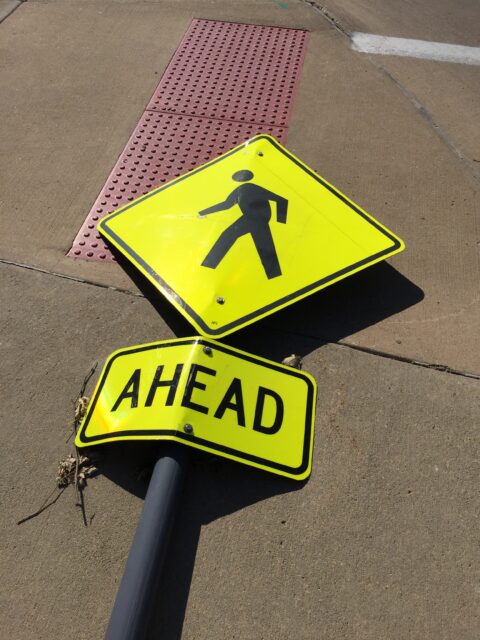
Cedar Rapids, Iowa, Aug. 21, 2020. Photo by Phil Smith
It’s a mercy that only a handful of people died because of the derecho, unlike other, more high-profile disasters. But the low death toll doesn’t communicate the severity of the property damage there. The place looks like a war zone.
Apart from the damage itself, what brought me to tears several times were the many instances of Iowans working together. There was a remarkable spirit of resilience. Total strangers were helping each other clear debris and tack on temporary siding.
At the high school and the library, they were handing out free meals and water to the folks who still lacked power.
- Cedar Rapids, Iowa, Aug. 21, 2020. Photo by Phil Smith
- Cedar Rapids, Iowa, Aug. 21, 2020. Photo by Phil Smith
- Cedar Rapids, Iowa, Aug. 21, 2020. Photo by Phil Smith
Some people had been coming there every day to volunteer and distribute food and diapers — even though they had their own yards to clear and roofs to fix. I spoke to one volunteer who said they’ve set up shop in the same places every day, since it’s hard to communicate with people who have been cut off from power and internet access. (She refused to accept an on-the-spot donation, by the way, and referred me to the United Way of East Central Iowa.)
And you know what was missing? Any single hint of partisanship. All the political yard signs had been carried off by the storm. At least for that moment, there were not Trump supporters and Biden supporters. There were just Iowans seeing each other through.
I hope Americans start paying attention to what’s going on there. The devastating aftermath is real, and underreported. But the love and pride there are real too. #CedarRapidsStrong, indeed.

Cedar Rapids, Iowa, Aug. 21, 2020. Photo by Phil Smith




